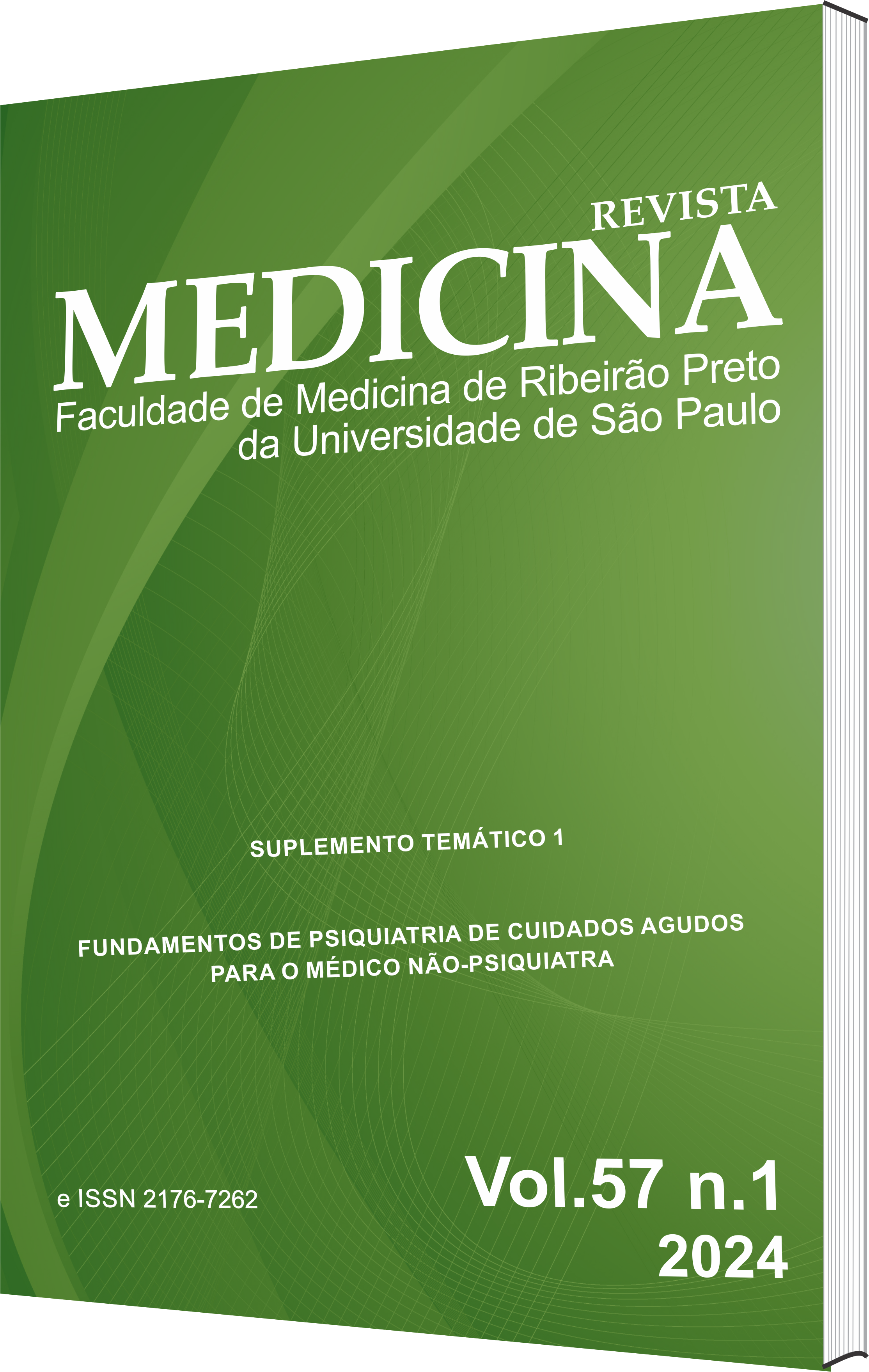Manejo do delirium para o clínico geral
DOI:
https://doi.org/10.11606/issn.2176-7262.rmrp.2024.222217Palabras clave:
Delirium, Estado confusional agudo, Morbimortalidade, Etiologia, TratamentoResumen
O atual artigo, que faz parte de um projeto de educação médica de temas centrais em psiquiatria, visa o aprimoramento de conhecimentos tanto para o estudante de medicina quanto para o médico generalista. Tendo-se em vista a alta prevalência do delirium em populações hospitalares e o mau prognóstico associado, é de extrema importância que não só o seu manejo seja conhecido, mas também medidas que possam prevenir o seu surgimento. O delirium é uma síndrome clínica cujos componentes principais são: alteração da atenção, flutuação do nível de consciência e desorganização do pensamento, de tal forma que tais sintomas flutuam ao decorrer do dia, podendo se apresentar nas formas hiperativa, hipoativa e mista. Há maior prevalência em pacientes graves, sobretudo internados em unidades de tratamento intensivo, e o seu surgimento denota pior prognóstico, assim é de extrema importância a sua prevenção e detecção precoce. O tratamento consiste em tratar a causa base, fator precipitante e administração de antipsicóticos, comumente haloperidol, para as formas hiperativas.
Descargas
Referencias
Gibb K, Seeley A, Quinn T, Siddiqi N, Shenkin S, Rockwood K, et al. The consistent burden in published estimates of delirium occurrence in medical inpatients over four decades: a systematic review and meta-analysis study. Age Ageing. 2020 Apr 27;49(3):352–60.
Krewulak KD, Stelfox HT, Leigh JP, Ely EW, Fiest KM. Incidence and Prevalence of Delirium Subtypes in an Adult ICU: A Systematic Review and Meta-Analysis*. Crit Care Med. 2018 Dec;46(12):2029–35.
Greaves D, Psaltis PJ, Ross TJ, Davis D, Smith AE, Boord MS, et al. Cognitive outcomes following coronary artery bypass grafting: A systematic review and meta-analysis of 91,829 patients. Int J Cardiol. 2019 Aug;289:43–9.
Hosie A, Davidson PM, Agar M, Sanderson CR, Phillips J. Delirium prevalence, incidence, and implications for screening in specialist palliative care inpatient settings: A systematic review. Palliat Med. 2013 Jun 17;27(6):486–98.
Witlox J, Eurelings LSM, de Jonghe JFM, Kalisvaart KJ, Eikelenboom P, van Gool WA. Delirium in Elderly Patients and the Risk of Postdischarge Mortality, Institutionalization, and Dementia. JAMA. 2010 Jul 28;304(4):443.
Marcantonio ER. Delirium in Hospitalized Older Adults. New England Journal of Medicine. 2017 Oct 12;377(15):1456–66.
Geriatric Medicine Research Collaborative. Delirium is prevalent in older hospital inpatients and associated with adverse outcomes: results of a prospective multi-centre study on World Delirium Awareness Day. BMC Med. 2019 Dec 14;17(1):229.
Khan A, PhD OB, Oh‐Park M, PhD NAF, PhD MS, Oldham M. Preventing Delirium Takes a Village: Systematic Review and Meta‐analysis of Delirium Preventive Models of Care. J Hosp Med. 2019 Sep 10;14(9):558–64.
Wilson JE, Mart MF, Cunningham C, Shehabi Y, Girard TD, MacLullich AMJ, et al. Delirium. Nat Rev Dis Primers. 2020 Nov 12;6(1):90.
Slooter AJC, Otte WM, Devlin JW, Arora RC, Bleck TP, Claassen J, et al. Updated nomenclature of delirium and acute encephalopathy: statement of ten Societies. Intensive Care Med. 2020 May 13;46(5):1020–2.
American Psychiatry Association. Manual diagnóstico e estatístico de transtornos mentais: DSM-5 - 5a Edição. 2014.
Mattison MLP. Delirium. Ann Intern Med. 2020 Oct 6;173(7):ITC49–64.
Inouye SK, Westendorp RG, Saczynski JS. Delirium in elderly people. The Lancet. 2014 Mar;383(9920):911–22.
Clegg A, Young JB. Which medications to avoid in people at risk of delirium: a systematic review. Age Ageing. 2011 Jan 1;40(1):23–9.
Pandharipande P, Cotton BA, Shintani A, Thompson J, Pun BT, Morris JA, et al. Prevalence and Risk Factors for Development of Delirium in Surgical and Trauma Intensive Care Unit Patients. Journal of Trauma: Injury, Infection & Critical Care. 2008 Jul;65(1):34–41.
van Montfort SJT, van Dellen E, Stam CJ, Ahmad AH, Mentink LJ, Kraan CW, et al. Brain network disintegration as a final common pathway for delirium: a systematic review and qualitative meta-analysis. Neuroimage Clin. 2019;23:101809.
Han JH, Wilson A, Graves AJ, Shintani A, Schnelle JF, Ely EW. A quick and easy delirium assessment for nonphysician research personnel. Am J Emerg Med. 2016 Jun;34(6):1031–6.
Hijazi Z, Lange P, Watson R, Maier AB. The use of cerebral imaging for investigating delirium aetiology. Eur J Intern Med. 2018 Jun;52:35–9.
Salvi F, Young J, Lucarelli M, Aquilano A, Luzi R, Dell’Aquila G, et al. Non-pharmacological approaches in the prevention of delirium. Eur Geriatr Med. 2020 Feb 2;11(1):71–81.
Breitbart W, Alici-Evcimen Y. Why off-label antipsychotics remain first-choice drugs for delirium. Curr Psychiatr. 2007;6(10).
American Geriatrics Society Abstracted Clinical Practice Guideline for Postoperative Delirium in Older Adults. J Am Geriatr Soc. 2015 Jan 12;63(1):142–50.
Devlin JW, Skrobik Y, Gélinas C, Needham DM, Slooter AJC, Pandharipande PP, et al. Clinical Practice Guidelines for the Prevention and Management of Pain, Agitation/Sedation, Delirium, Immobility, and Sleep Disruption in Adult Patients in the ICU. Crit Care Med. 2018 Sep;46(9):e825–73.
Saczynski JS, Marcantonio ER, Quach L, Fong TG, Gross A, Inouye SK, et al. Cognitive Trajectories after Postoperative Delirium. New England Journal of Medicine. 2012 Jul 5;367(1):30–9.
Rudolph JL, Archambault E, Kelly B. A Delirium Risk Modification Program Is Associated With Hospital Outcomes. J Am Med Dir Assoc. 2014 Dec;15(12):957.e7-957.e11.
Descargas
Publicado
Número
Sección
Licencia
Derechos de autor 2024 João Roberto Fernandes Lisboa, Luis Felipe Izycki, Hernani Conforti, Alcion Sponholz Junior

Esta obra está bajo una licencia internacional Creative Commons Atribución 4.0.







